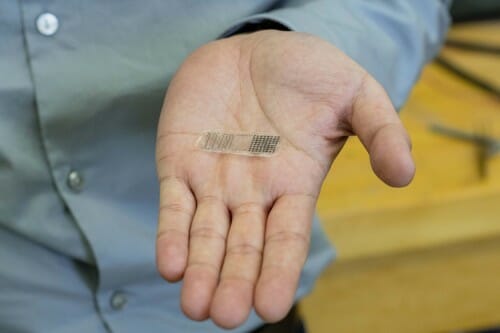1. One thing that helpsZap The Fracture

I learnt this week that electricity is the key to healing bone fractures quickly. The reason it hasn't caught on as a mainstream treatment is that they have to surgically implant, and then remove electrodes which need to be powered by an external source. Professor Xudong Wang from the University of Wisconsin is developing a self-powered device that dissolves after it has done its job zapping the bone.The new "fracture electrostimulation device" converts mechanical energy into electrical power. The electric field generated is then distributed to the bone directly. The device was able to produce around 4 volts and was tested on rats with fractured bones (I really don't want to think about how they got fractured bones). Those which received the device healed more quickly with the same quality of the result. Professor Wang says this device can be scaled up to work on humans with the main challenge being how to power the device. Whilst our rat friends are running around creating heaps of mechanical energy, a human with a broken arm won't be moving it much. This means the energy will need to come from another source. Professor Wang says, “We may need the device to respond to other types of internal mechanical sources, like blood pressure changes.” If I was Professor Wang I would be headed to sports teams for funding. The ability to get injured players back on the field quickly is something I am sure they would pay handsomely for.2. One to be wary ofShotspotter FailingsWhen does a new technology service become usable in a court of law? This is a constant challenge for our legislators that really came to the fore with the introduction of DNA evidence. Now Shotspotter is a new evidence technology under the spotlight.Shotspotter is a surveillance system that detects and locates gunshots using hidden microphone sensors. In 2016 police in New York stopped Silvon Simmon's car. They shot Simmons three times in the back and charged him with firing first at the officers. The only evidence brought against him was the Shotspotter data. In this case, the Shotspotter algorithm initially detected helicopter rotors in the area and not gunshots. After police requested that Shotspotter look at the data again a Shotspotter analyst changed the findings to say there were 4 gunshots. A subsequent extra police request then resulted in the discovery of a fifth gunshot. It all sounds a little untested and subjective to me.Rigorous testing and assessment need to be applied to every technology that can be used to decide guilt or innocence. Life in jail or freedom. This is not an easy task and is one that will need to be done individually for each new technology that is introduced.3. One to amazeDe-extinction Begins[video width="1024" height="682" mp4="https://danielmckinnon.com.au/wp-content/uploads/2021/08/dinooo.mp4"][/video]The Jurassic Park movies awed us with the idea that one day we can bring back extinct creatures to life (and hope they don’t escape). Well, we may just be at the dawn of de-extinction, bringing extinct animals back to life.With CRISPR, the gene-editing tool that fascinates scientists all over the world, we can reactivate dormant genes in animals to "turn on" lost traits like bigger teeth or a tail. If we wanted to bring back an entire mammoth, we need to pair small amounts of DNA we have with the genome of its closest living relative, the Asian elephant.Another option is cloning. To clone something (like Dolly the sheep) you need a live cell. This means cloning is usually not going to bring back extinct species. However... you can take an egg from a host animal and get rid of the DNA nucleus within by replacing it with the DNA of our extinct animal. Then give it a jolt of electricity to fuse the egg and new DNA and you got yourself a dinosaur! Simple right? The tech is nowhere near perfect, and still a little scary, but the results are promising. Using these methods, it is hoped that we can bring back the Tasmanian Tiger with the help of the Tasmanian Devil. If a Tiger-Devil hybrid doesn’t fascinate you, I wonder what will?